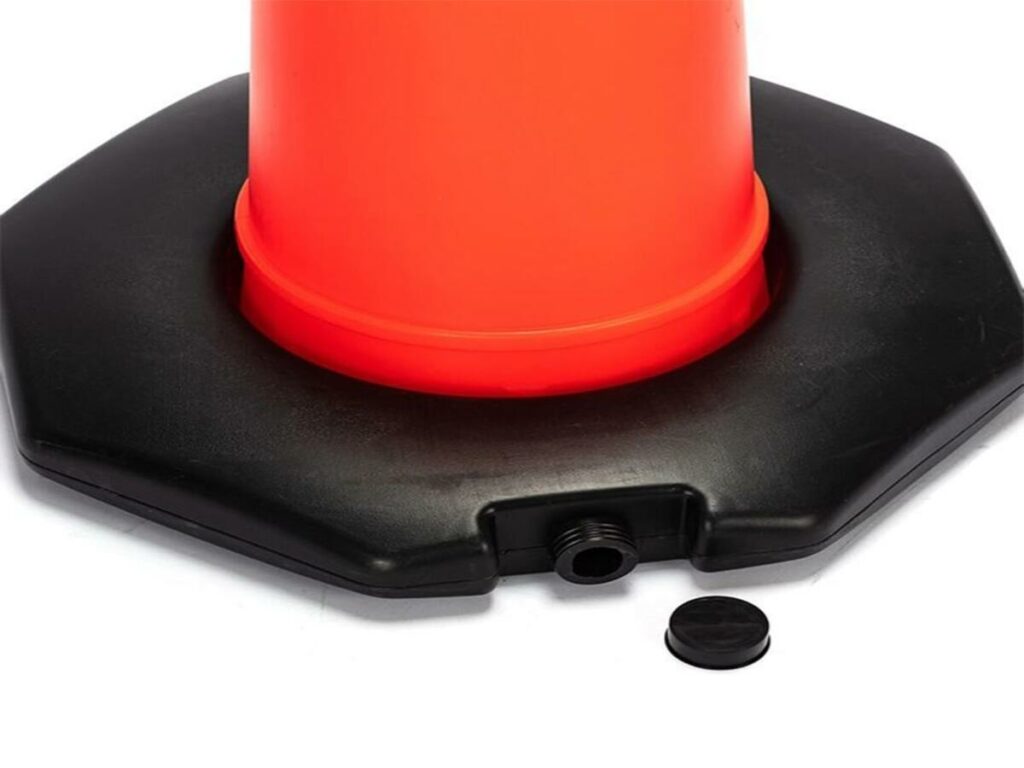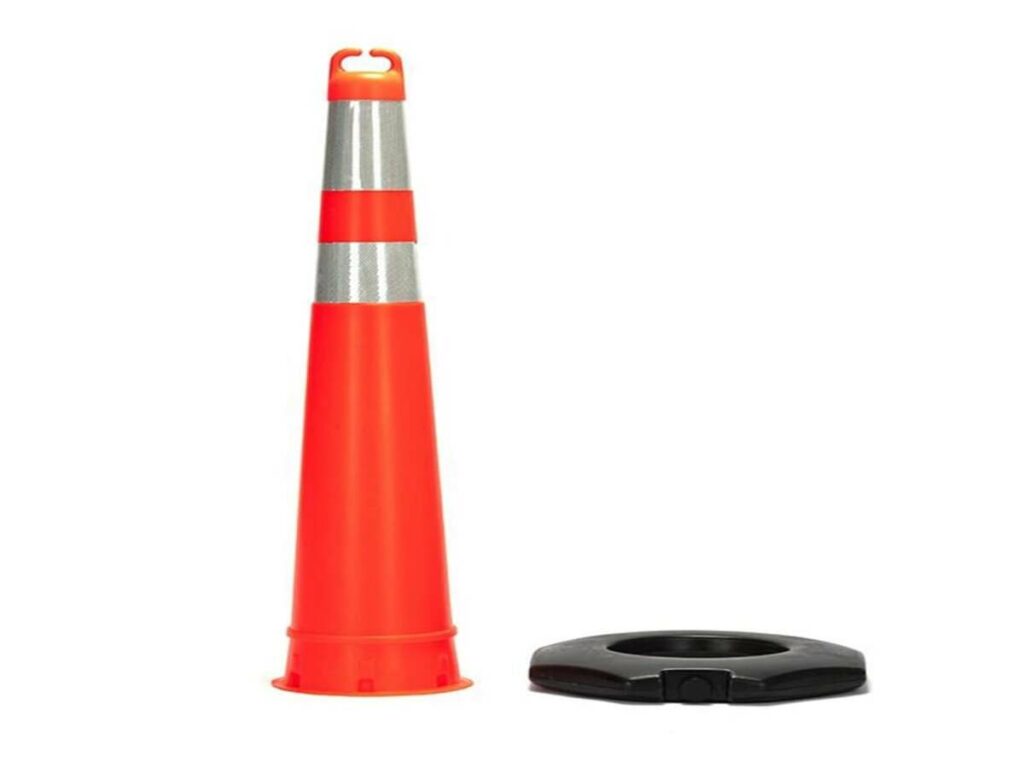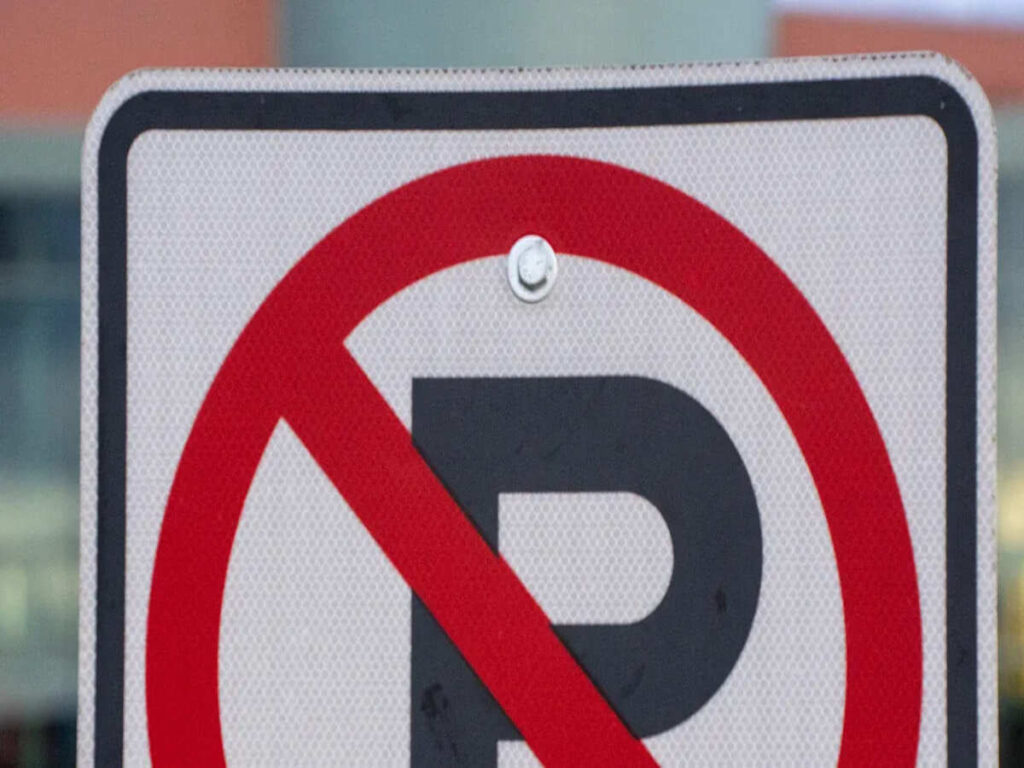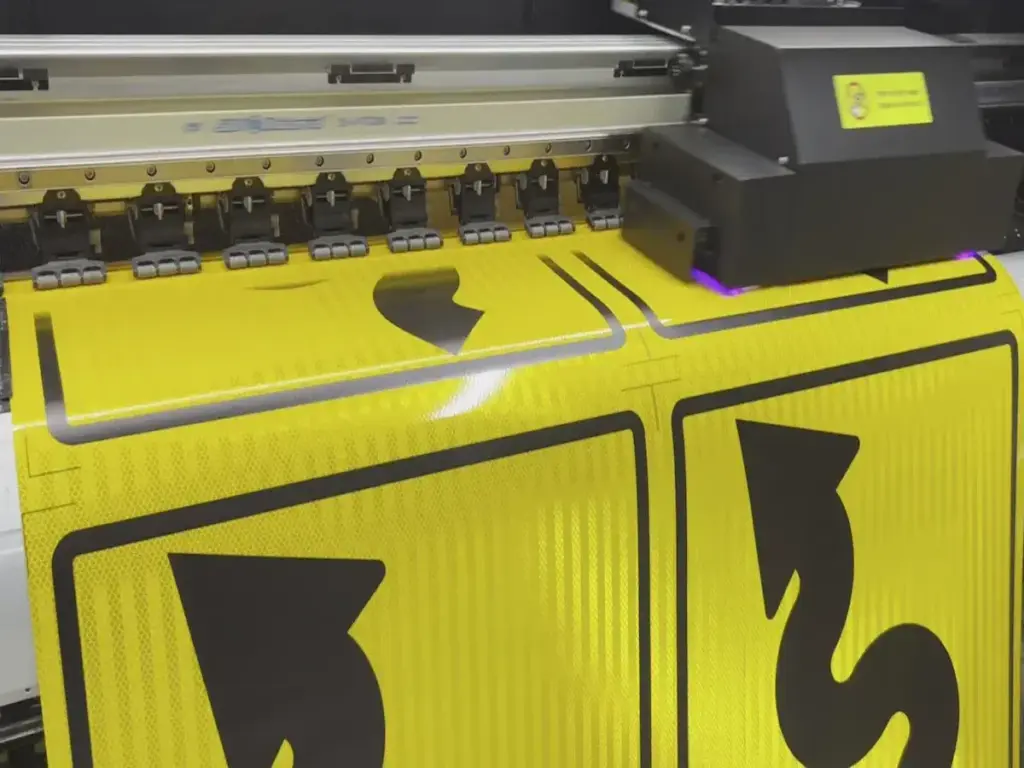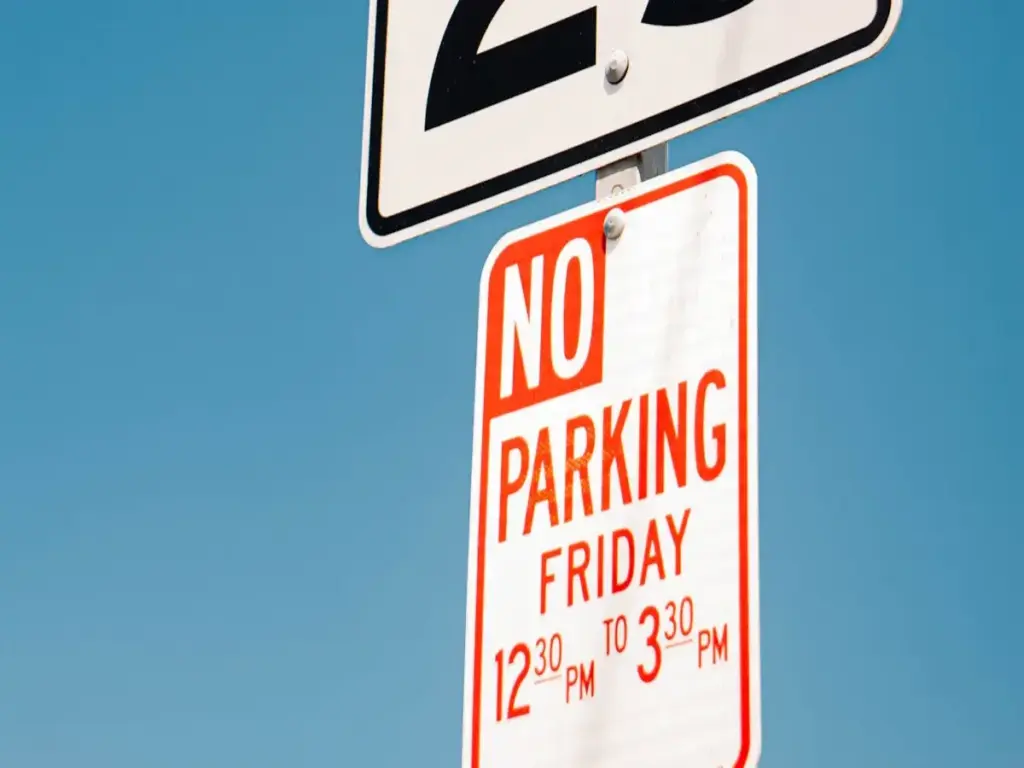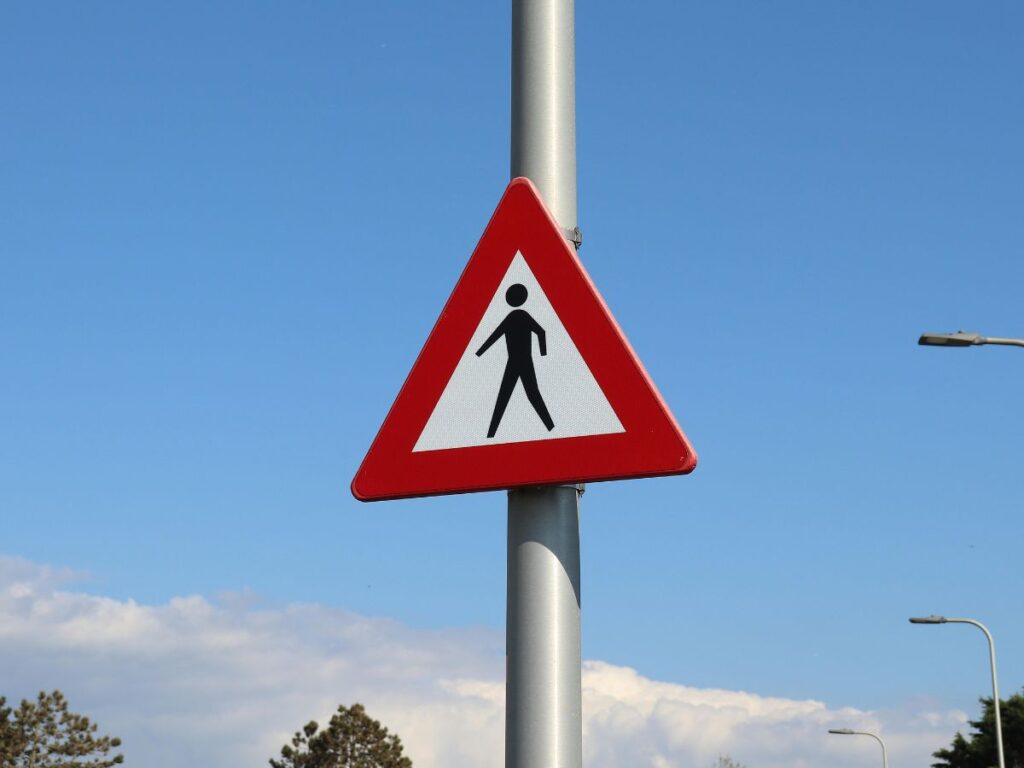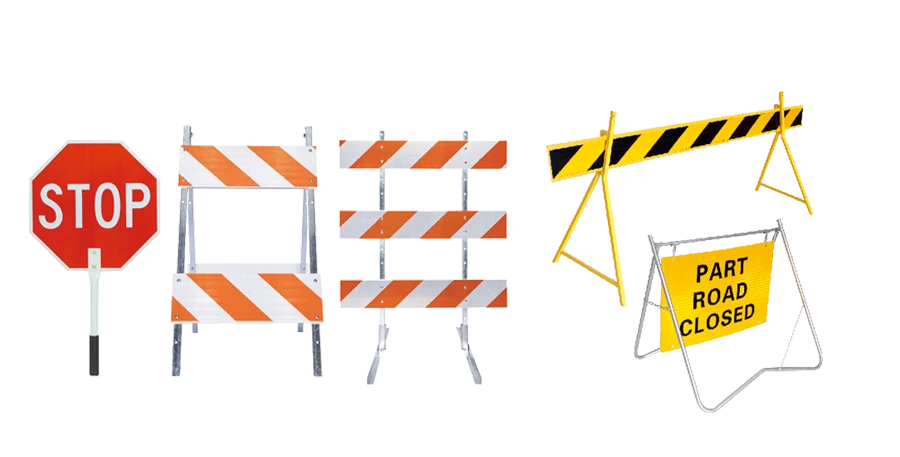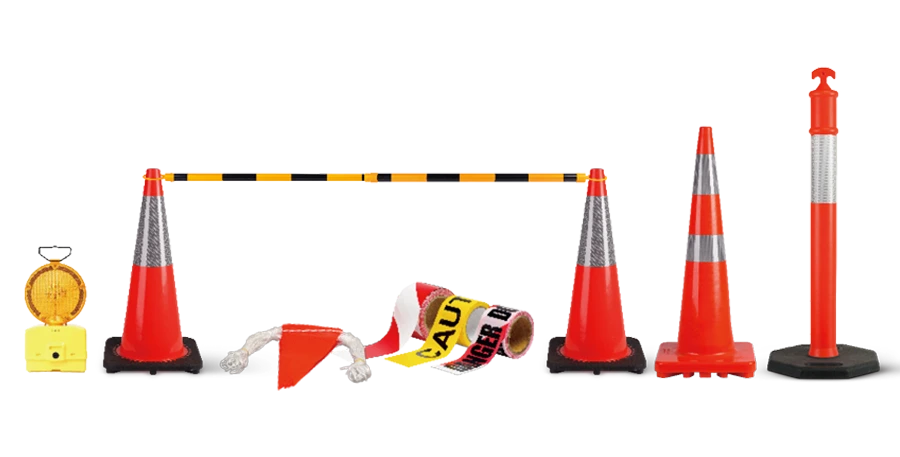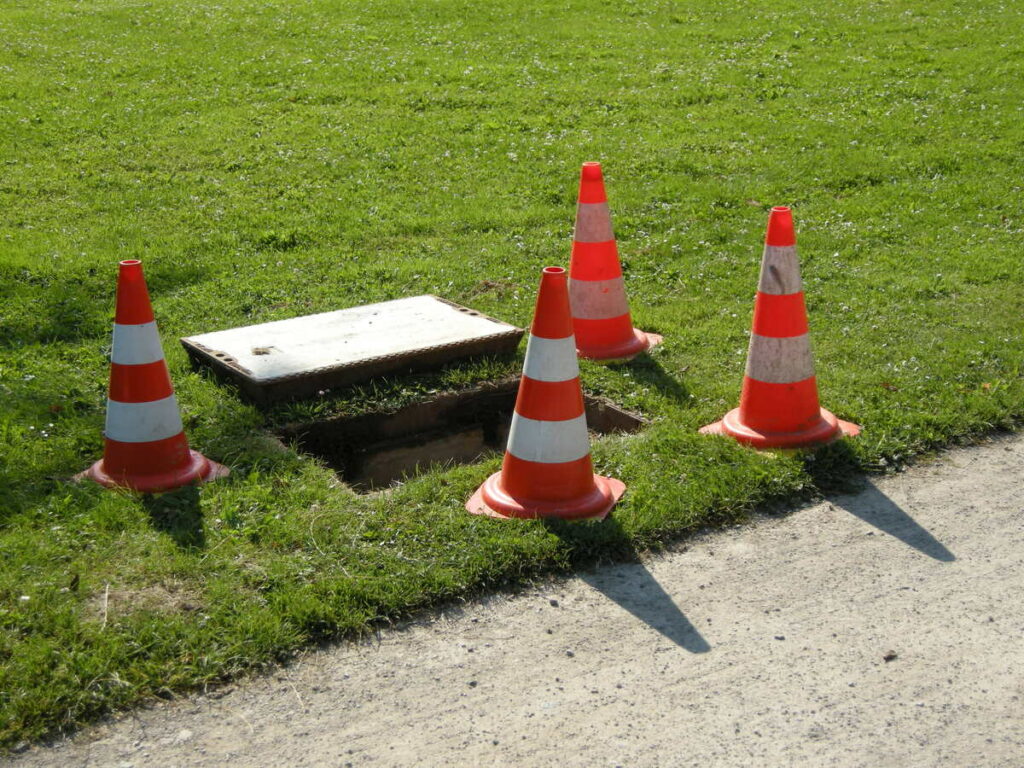
Remplir des délimitants avec de la base à l'aide de l'eau est un processus simple. Commencez par localiser la soupape de remplissage sur la base. Utilisez un tuyau ou un récipient pour verser de l'eau dans l'ouverture jusqu'à ce que la base atteigne le poids souhaité. Sceller fermement la valve pour éviter les fuites. Ce poids supplémentaire garantit que le délimiteur reste stable, Même dans des conditions venteuses ou des zones de circulation lourde.
Dans les régions où l'eau est rare, des alternatives comme le sable ou le gravier peuvent offrir une stabilité similaire. Ces matériaux offrent une solution pratique tout en préservant les ressources en eau.
Signes OPT offres Cannez des délimitateurs de cône avec bases remplies d'eau, fournir une solution stable et durable pour divers besoins de gestion du trafic, tout en assurant la durabilité environnementale avec des matériaux réutilisables et recyclables.
Outils et matériaux pour remplir les délinéateurs avec une base
Outils pour bases remplies d'eau
Pour remplir les délinéateurs avec une base avec de l'eau, vous avez besoin de quelques outils simples. UN tuyau d'arrosage est l'option la plus pratique pour transférer de l'eau dans la base. Si un tuyau n’est pas disponible, un grand récipient ou un seau fonctionne bien. Un entonnoir peut vous aider à verser de l'eau sans en renverser, surtout si le robinet de remplissage est petit. Vous aurez également besoin d’une clé ou d’une pince pour bien serrer le bouchon de la valve après le remplissage.. Ces outils garantissent que le processus est rapide et efficace.
Matériaux pour bases remplies d'eau
L'eau est le matériau principal de cette méthode. L'eau propre est idéale pour éviter le colmatage ou l'endommagement de la vanne. Si vous travaillez dans des climats plus froids, pensez à ajouter une petite quantité de antigel non toxique pour éviter que l'eau ne gèle. Cela maintient la base fonctionnelle toute l’année. Vérifiez toujours les directives du fabricant pour garantir la compatibilité avec les additifs..
Outils et matériaux pour les méthodes de remplissage alternatives
Dans les zones pauvres en eau, des matériaux alternatifs comme le sable ou le gravier sont d'excellentes options. Pour remplir la base de sable, vous aurez besoin d'une cuillère solide ou d'une petite pelle. Un entonnoir est également utile pour diriger le matériau vers la base. Pour le gravier, une cuillère ou même vos mains peuvent travailler, selon la taille des pierres. Si vous utilisez caoutchouc recyclé ou d'autres matériaux innovants, assurez-vous qu’ils sont propres et secs avant de les remplir. Un balai ou une brosse peut aider à éliminer les débris de l'ouverture de la base avant de la sceller.
Conseil: Inspectez toujours vos outils et votre matériel avant de commencer. Cela garantit un processus fluide et évite des retards inutiles..
Guide étape par étape pour remplir les délinéateurs avec une base à l'aide d'eau
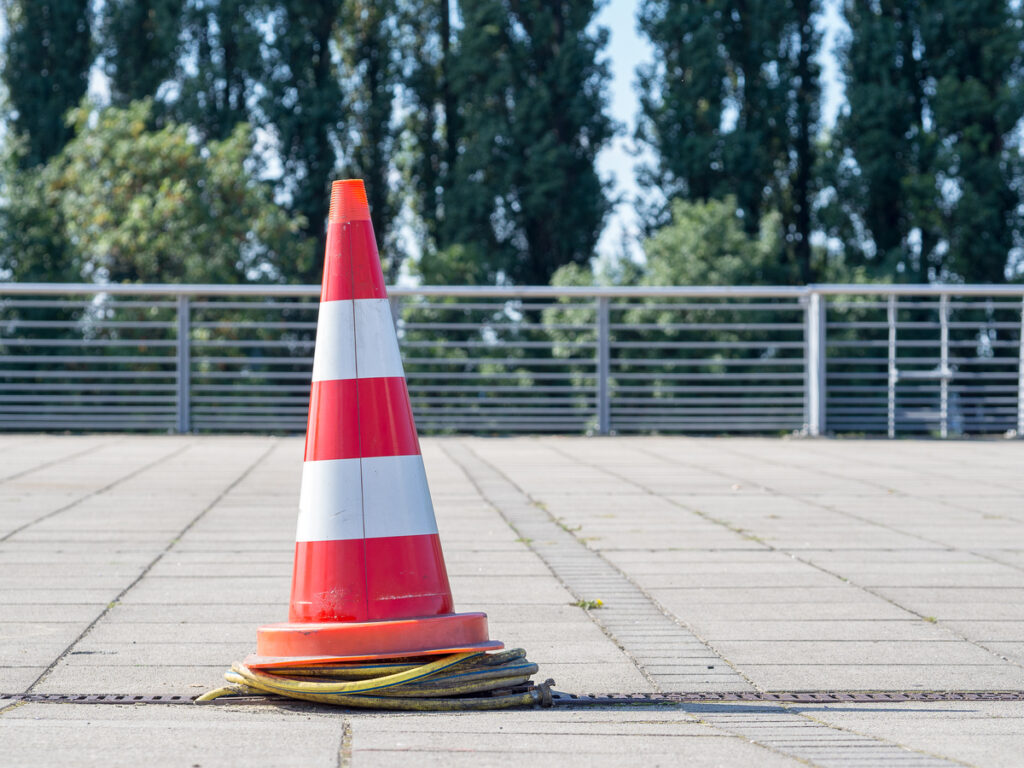
Préparation de la base
Commencez par inspecter le cône délinéateur et sa base pour déceler tout dommage visible.. Chercher des fissures, fuites, ou des débris qui pourraient interférer avec le processus de remplissage. Nettoyer soigneusement la base à l'aide d'un chiffon humide ou d'une brosse pour enlever la saleté ou la poussière. Cela garantit une bonne étanchéité plus tard. Localisez le robinet de remplissage ou l'ouverture sur la base.. Il est généralement marqué ou positionné sur le côté ou sur le dessus de la base.. Assurez-vous que la valve n'est pas obstruée avant de continuer..
Conseil: Si la base a été stockée pendant une longue période, vérifier les signes d'usure ou de vieillissement. Le remplacement des pièces usées peut éviter les fuites ou l'instabilité.
Remplir la base avec de l'eau
Positionner les délinéateurs avec base sur une surface plane pour le maintenir stable pendant le processus de remplissage. Utilisez un tuyau d'arrosage ou un récipient pour verser de l'eau dans le robinet de remplissage.. Un entonnoir peut vous aider à éviter les déversements, surtout si l'ouverture est petite. Remplissez la base progressivement, faire une pause de temps en temps pour vérifier le poids. L'objectif est d'obtenir suffisamment de poids pour stabiliser le cône délinéateur sans trop le remplir..
Si vous travaillez dans des climats plus froids, pensez à ajouter une petite quantité d'antigel non toxique à l'eau. Cela évite le gel et maintient la base fonctionnelle en hiver. Suivez toujours les recommandations du fabricant pour les additifs.
Scellement et fixation de la base
Une fois la base remplie, fermez bien le robinet de remplissage. Utilisez une clé ou une pince pour vous assurer que le capuchon est bien fixé.. Cela évite les fuites et maintient l'eau à l'intérieur. Après scellement, tester la stabilité du délinéateur en le poussant doucement. Si ça vacille, ajuster le poids en ajoutant ou en retirant de l'eau.
Note: Inspectez régulièrement la base pour déceler des fuites ou des déséquilibres de poids. Un entretien approprié garantit la stabilité et la sécurité à long terme.
Les défis des bases remplies d'eau
Problèmes courants avec les bases remplies d'eau
Les bases remplies d'eau offrent une commodité, mais ils comportent des défis. Les fuites sont l'un des problèmes les plus courants. Au fil du temps, l'usure de la valve ou du matériau de base peut provoquer une fuite d'eau. Cela réduit le poids et la stabilité des délinéateurs avec base, les rendre moins efficaces. Vous pouvez également rencontrer des difficultés dans les climats plus froids. Les températures glaciales peuvent provoquer une expansion de l'eau à l'intérieur de la base., entraînant des fissures ou des dommages.
Le transport de l'eau vers des endroits éloignés peut être un autre problème. Si vous travaillez dans des zones sans accès facile à l’eau, remplir les bases devient une tâche fastidieuse. En plus, une mauvaise étanchéité de la valve peut entraîner des déversements pendant le transport ou l'utilisation. Des inspections et un entretien réguliers sont essentiels pour éviter ces problèmes.
Limites environnementales et pratiques
L'utilisation de l'eau comme matériau de remplissage a des implications environnementales. Dans régions sujettes à la sécheresse, l'eau est une ressource précieuse. Remplir plusieurs bases peut mettre à rude épreuve les approvisionnements locaux, surtout pendant les saisons sèches. Vous devez également considérer l’aspect pratique de l’utilisation de l’eau dans les zones soumises à des conditions météorologiques extrêmes.. Par exemple, dans les climats chauds, évaporation peut réduire le niveau d'eau à l'intérieur de la base, nécessitant des recharges fréquentes.
Le poids des bases remplies d'eau peut également poser des problèmes. Bien qu'ils soient faciles à déplacer lorsqu'ils sont vides, leur poids rempli peut rendre le repositionnement difficile. Cela est particulièrement vrai pour les projets à grande échelle où plusieurs délinéateurs nécessitent des ajustements fréquents..
Pourquoi des alternatives peuvent être nécessaires
Les alternatives aux bases remplies d’eau deviennent essentielles dans des scénarios spécifiques. Dans les zones pauvres en eau, des matériaux comme le sable ou le gravier offrent une option plus durable. Ces matériaux sont souvent disponibles localement, réduisant le besoin de transport. Ils éliminent également les risques de fuites ou de gel, les rendant plus fiables dans des conditions extrêmes.
Le choix de la bonne alternative dépend de votre emplacement et des besoins du projet. En explorant des options au-delà de l’eau, vous pouvez assurer la stabilité de vos délinéateurs tout en répondant aux préoccupations environnementales et pratiques.
Alternatives pour les zones pauvres en eau
Utiliser du sable comme matériau de remplissage
Le sable est l’une des alternatives les plus pratiques pour remplir les bases des délinéateurs dans les zones où l’eau est rare.. Il est largement disponible et facile à manipuler. Vous pouvez utiliser une pelle ou une petite pelle pour transférer le sable dans la base. Un entonnoir peut vous aider à le verser efficacement sans renverser. Une fois rempli, le sable offre un excellent poids et une excellente stabilité, Même dans des conditions venteuses.
Le sable offre également de la flexibilité. Vous pouvez ajuster la quantité pour obtenir le poids souhaité pour vos délinéateurs de trafic. Cela en fait une option fiable pour divers environnements. Cependant, assurez-vous toujours que le sable est sec avant de remplir. L'humidité peut provoquer des agglomérations, ce qui peut affecter l'équilibre de la base.
Conseil: Conservez le sable dans un endroit sec pour le garder prêt à l'emploi en cas de besoin.
Du gravier ou de la pierre concassée comme alternative
Gravier ou la pierre concassée constitue une autre option efficace. Ces matériaux sont durables et offrent un poids important pour stabiliser les délinéateurs avec base.. Vous pouvez utiliser une cuillère ou vos mains pour remplir la base, selon la taille des pierres. Le gravier est particulièrement utile dans les environnements extérieurs où les vents violents ou les vibrations de la circulation sont fréquents..
Contrairement au sable, le gravier ne se compacte pas aussi facilement, ce qui aide à maintenir une répartition constante du poids. Il résiste également à l'humidité, ce qui le rend adapté aux régions très humides ou pluvieuses occasionnelles. Choisissez toujours propre, gravier sec pour empêcher les débris de boucher l'ouverture de la base.
Note: Le gravier peut ajouter plus de poids que le sable, alors manipulez-le avec soin pendant le transport.
Caoutchouc recyclé et autres solutions innovantes
Le caoutchouc recyclé offre une solution moderne et écologique pour remplir les bases des délinéateurs. Ce matériau est léger lorsqu'il est vide mais offre une excellente stabilité une fois installé. Il est portable, facile à manipuler, et conçu pour fonctionner de manière transparente avec la plupart des tubes délinéateurs.
Le caoutchouc recyclé est robuste et durable, ce qui le rend idéal pour les environnements extérieurs difficiles. Il résiste à l'usure, assurer un ancrage fiable pour les équipements de sécurité. Ce matériau innovant soutient également la durabilité en réutilisant les déchets de caoutchouc en un produit fonctionnel..
Avantages du caoutchouc recyclé:
- Portable et facile à manipuler.
- Durable et adapté à une utilisation en extérieur.
- Fournit une alternative fiable et écologique.
En explorant ces alternatives, vous pouvez assurer la stabilité de vos délinéateurs tout en économisant l'eau et en soutenant des pratiques durables.
Conseils pour maintenir la stabilité et la sécurité
Assurer une bonne répartition du poids
Une bonne répartition du poids est essentielle pour maintenir la stabilité des délimiteurs de trafic à vendre. Lors du remplissage de la base, s'assurer que le matériau se répartit uniformément. Un poids inégal peut faire basculer ou tomber le délinéateur., surtout par temps venteux. Si vous utilisez du sable ou du gravier, secouer doucement la base après le remplissage. Cela aide le matériau à se déposer et assure une distribution uniforme.. Pour bases remplies d'eau, vérifier le poids en poussant légèrement le délinéateur. Si ça vacille, ajustez le niveau d’eau jusqu’à ce qu’il soit sécurisé.
Conseil: Placez toujours les délinéateurs sur des surfaces planes. Un sol inégal peut compromettre la stabilité, même avec une bonne répartition du poids.
Entretien régulier des bases
Un entretien régulier maintient vos délinéateurs avec base en parfait état. Inspectez fréquemment les bases des cônes pour détecter tout signe d'usure., comme des fissures ou des fuites. Pour bases remplies d'eau, vérifiez la valve pour vous assurer qu'elle est hermétiquement fermée. Remplacez immédiatement les pièces endommagées pour éviter les accidents. Si vous utilisez du sable ou du gravier, retirez tous les débris qui pourraient obstruer l’ouverture de la base. Nettoyer périodiquement les bases empêche l'accumulation et prolonge leur durée de vie.
Note: Conservez les bases inutilisées dans un endroit sec, zone ombragée. Cela évite les dommages dus à une exposition prolongée au soleil ou à l'humidité..
Conseils de sécurité pour différents matériaux de remplissage
Chaque matériau de remplissage a des considérations de sécurité uniques. Pour bases remplies d'eau, éviter de trop remplir pour éviter les fuites. Dans les climats plus froids, ajoutez de l'antigel non toxique pour empêcher l'eau de geler. Lors de l'utilisation de sable, assurez-vous qu'il est sec pour éviter les agglomérations. Le sable humide peut créer une répartition inégale du poids. Le gravier doit être propre et exempt d'arêtes vives pour éviter d'endommager la base.. Si vous choisissez le caoutchouc recyclé, manipulez-le avec soin pour éviter les déversements pendant le transport.
Rappel: Portez toujours des gants lorsque vous manipulez des matériaux de remplissage. Cela protège vos mains de la saleté, objets pointus, ou produits chimiques.
Remplir les délinéateurs avec une base à l'aide d'eau implique des étapes simples. Vous préparez la base, remplis-le d'eau, et scellez-le solidement pour assurer la stabilité. Cette méthode fonctionne bien dans les zones avec un accès fiable à l'eau. Cependant, dans les régions pauvres en eau, des alternatives comme le sable, gravier, ou du caoutchouc recyclé apportent des solutions efficaces. Ces matériaux offrent une durabilité et maintiennent la stabilité dans des conditions difficiles.
Pour garder vos délinéateurs stables et sûrs, inspectez-les régulièrement. Vérifier les fuites, poids inégal, ou dégâts. Choisissez toujours le bon matériau en fonction de votre environnement et des besoins de votre projet. Cela garantit une fiabilité et une sécurité à long terme.
FAQ
1. Comment savoir si la base est correctement remplie?
Vérifiez la stabilité du délinéateur en le poussant doucement. Si ça vacille, ajuster le poids en ajoutant ou en retirant le matériau de remplissage. Pour bases remplies d'eau, assurez-vous que la valve est hermétiquement scellée pour éviter les fuites.
2. Pouvez-vous mélanger des matériaux comme du sable et du gravier dans une seule base?
Oui, vous pouvez mélanger du sable et du gravier pour obtenir le poids souhaité. Cependant, s'assurer que les matériaux sont propres et secs. Le mélange peut aider à équilibrer la répartition du poids et à améliorer la stabilité dans des environnements difficiles.
3. Que devez-vous faire si la base fuit?
Inspectez la base pour déceler des fissures ou des dommages. Remplacez immédiatement la vanne ou les pièces endommagées. Pour les correctifs temporaires, utiliser du ruban adhésif ou du scellant imperméable. Un entretien régulier aide à prévenir les fuites et assure la stabilité à long terme.
4. Le caoutchouc recyclé est-il sans danger pour une utilisation en extérieur?
Le caoutchouc recyclé est très durable et sans danger pour une utilisation en extérieur. Il résiste à l'usure, ce qui le rend idéal pour les conditions météorologiques difficiles. Assurez-vous toujours que le matériau est propre et exempt de contaminants avant de remplir la base..
5. À quelle fréquence devez-vous inspecter les bases?
Inspectez les bases des cônes chaque semaine ou avant chaque utilisation. Recherchez des signes d'usure, fuites, ou répartition inégale du poids. Des contrôles réguliers garantissent que les délinéateurs restent stables et sûrs dans toutes les conditions.
Conseil: Conservez une liste de contrôle de maintenance pour suivre les inspections et les réparations pour une meilleure organisation.

